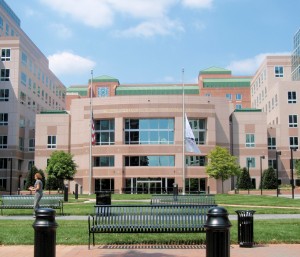ANALYSIS: Naniloa – Local Crisis, Mainland Asset (Part 2 of 2)
Editor’s note: see part 1 of our in-depth series on the Naniloa’s woes here.
Riding up the elevator of the hotel’s main building, a 20-year housekeeping veteran scrubs its floors in earnest. He stops to hold the doors open, bidding a cheerful farewell.
Stepping out onto the 10th floor, the hotel’s “Kilohana Room” is momentarily locked, the venue only partially visible through a glass panel. The space has long been a point of pride here, and it’s easy to understand why.
Although the lights are off, sunlight floods in through the windows, illuminating rich wood trim in an event room that has, without a doubt, one of the best views on the island.
——————————————————————————————————————
Despite the tangled heap of legal issues surrounding the Naniloa’s foreclosure and subsequent bankruptcy, most of the key people involved seem to agree on one key point:
At least for now, the Naniloa’s fate rests largely with First Citizens Bank.
When First Citizens purchased the assets of the failed “First Regional Bank” from the Federal Deposit Insurance Corporation back in 2008, it likely scooped up First Regional’s loans (including the one issued to finance Ken Fujiyama’s Naniloa purchase) at a relative bargain, according to sources familiar with the bankruptcy case.
Just how much of a bargain is unclear, but such transactions were commonplace during the financial free-fall of 2008, as the federal government raced to shore up the banking system.
Apart from getting bad loans on the cheap, banks with sufficient cash at the time (including First Citizens) were granted share-loss agreements with the federal government. Typically, share loss agreements guarantee 80% of the purchasing bank’s investment against losses.
David Farmer, the court-appointed bankruptcy trustee in the case, described the bank’s legal standing in an interview with Big Island Now on Oct. 3. Farmer explained that no matter what First Citizens actually paid for the loan associated with the Naniloa, they have a legal claim “to the full amount owed…”
That figure is now approaching $11 million.
Farmer was appointed trustee in the case by a court order, after complaints by First Citizens were filed accusing Fujiyama of mismanaging the hotel and failing to keep accurate records. The bank also questioned some $775,000 in payments it said Fujiyama made to himself, his family and subsidiary companies prior to declaring bankruptcy.
Farmer said that Colliers International, the broker tasked with selling the Naniloa property during bankruptcy, has set a Oct. 18 deadline for all bids to purchase the resort.
According to Farmer, “we haven’t had any bids or specific offers, just interest.” Farmer explained that “there is no listing price, all we can tell [potential buyers] is there are ‘xyz’ creditors to pay.”
Farmer said, “Our best outcome is to have someone on deck by October 18 so we can tell the court there is a potential buyer.”

First Citizen’s bank is protected against up to 80% of its losses thanks to a loss-share agreement with the FDIC (Arlington offices pictured here).
Assuming that deadline passes without an offer, Farmer explained that the next key hearing would be on Oct. 21, where a judge would decide whether the lease is put in the hands of the bankrupt estate.
Theoretically, if the judge were to decline to do so, the Department of Land and Natural Resources could then begin the long, multi-stage process of canceling the lease. DLNR has been unable to touch the lease during bankruptcy, according to Land Division head Russell Tsuji.
But in all likelihood, according to Farmer, First Citizens Bank won’t let things get that far.
Farmer says it’s possible the bank would “step up by [the October 21] deadline” to purchase the hotel, as it has the option to make an offer on its own, known as a “credit bid.”
As a secured creditor, the bank is able to bid up to the amount of its claim while putting zero cash down. Credit bidding is a right granted to secured creditors in the US Bankruptcy Code.
According to Farmer, “if they get it for a song, they could sell it off and keep the rest.”
In separate interviews with Big Island Now, both Tsuji and Fujiyama voiced similar sentiments, with both saying it was in the bank’s interest to keep the lease active.
“It would be foolish for any party… the bank, the trustees, the state… to close the hotel,” said Fujiyama, who is currently seeking a joint venture to continue operating the resort.
Fujiyama explained that closing the hotel would only speed deterioration and increase costs. He estimated that to finish renovating the property, an additional $6 million in improvements would be needed.
DLNR’s Russell Tsuji explained that if no buyers (including the bank) were to come forward, the state would likely move forward with canceling the lease. Although some politicians have been vocal about wanting the lease canceled, Tsuji warned that a cancellation probably wouldn’t provide a clean outcome.
If that were to happen, Tsuji said, “We [the state] would probably get sued.”
————————————————————————————————-
Outside the hotel, along the shoreline, things are much as they were a hundred years ago. Two groups of locals fish on the ocean’s edge, while another man stands in the waist-deep waters of an inlet in an effort to get closer to his catch.
Paddlers quietly skim across the bay, while a sailboat can be seen in the distance preparing to depart for the open ocean.
As the man in the water tugs at his line, a pair of native nene geese waddle up from the shore, making their way toward the hotel’s edge.
As if on cue, they stop to peer through the windows of an empty dining room… nature briefly distracted by man’s misadventures.


















